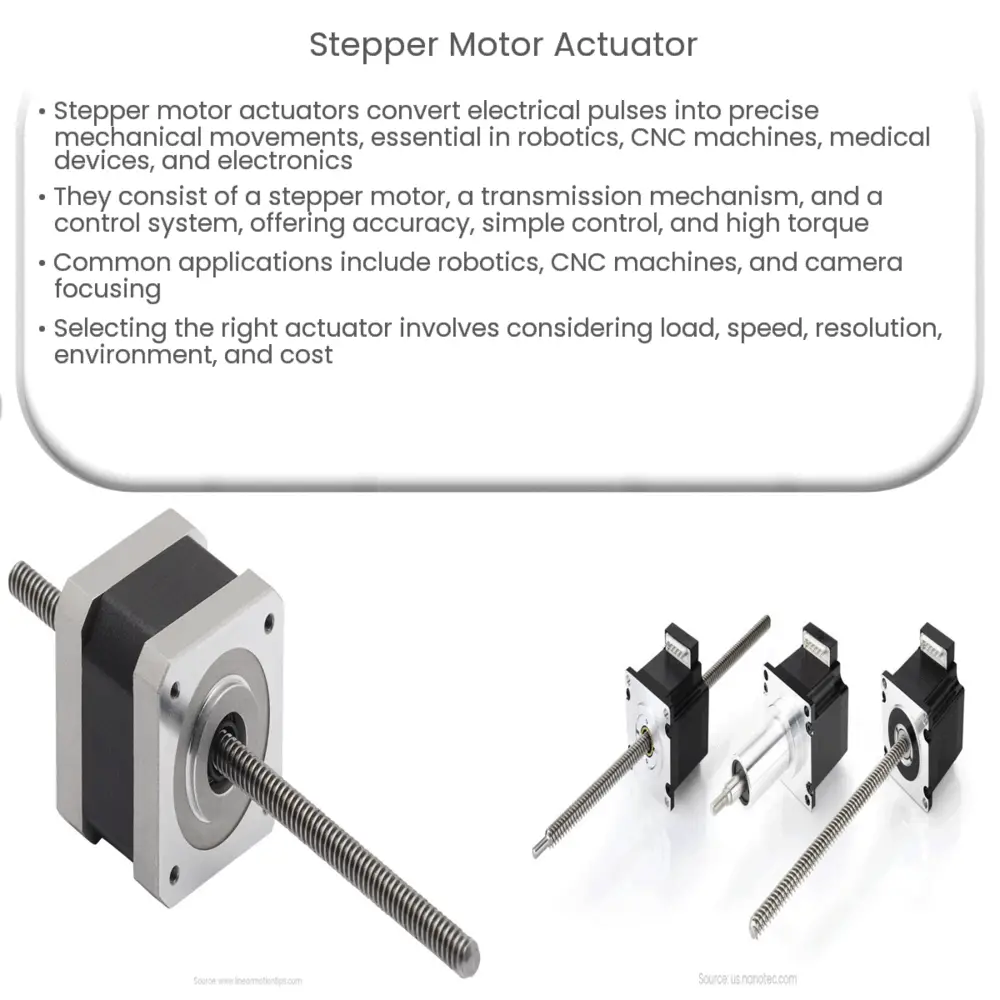Stepper motor actuators are precision devices that convert electrical pulses into controlled mechanical movements, widely used in robotics, CNC machines, and medical devices.

Stepper Motor Actuator: A Comprehensive Overview
Introduction
Stepper motor actuators are electromechanical devices that convert electrical pulses into mechanical movements. These precision instruments have become essential components in a wide range of applications, from robotics and CNC machines to medical devices and consumer electronics. In this article, we will explore the fundamentals of stepper motor actuators, their advantages, and common applications.
What is a Stepper Motor Actuator?
A stepper motor actuator consists of a stepper motor, a mechanical transmission mechanism, and a control system. The stepper motor, which is the primary component, is a type of synchronous electric motor that moves in discrete steps or increments, rather than continuously like other motors. Each step corresponds to a specific angular rotation, allowing for precise positioning and control without the need for a feedback mechanism.
The mechanical transmission in a stepper motor actuator transforms the motor’s rotary motion into linear or other types of motion, such as helical, depending on the application’s requirements. Common mechanical transmission mechanisms include lead screws, ball screws, and belts and pulleys.
Finally, the control system manages the stepper motor’s operation by sending electrical pulses to the motor’s windings. These pulses determine the motor’s speed, direction, and step size, allowing the actuator to achieve precise positioning and control.
Advantages of Stepper Motor Actuators
Stepper motor actuators offer several advantages over other types of actuators, including:
- Precision and Accuracy: Stepper motor actuators provide high-resolution positioning, often measured in micrometers or even nanometers. The precision of these actuators makes them ideal for applications requiring exact movements, such as in the semiconductor industry and scientific research.
- Simple Control: The open-loop control system used in stepper motor actuators eliminates the need for complex feedback mechanisms, making them easier to control and program. This simplicity reduces system complexity and cost.
- High Torque at Low Speeds: Stepper motor actuators can generate high torque even at low speeds, making them well-suited for applications requiring high holding or starting torque, such as robotics or CNC machines.
- Reliability: With no brushes or contact between the rotor and stator, stepper motors have a long operational life and low maintenance requirements. This reliability contributes to their widespread use in various industries.
Common Applications
Stepper motor actuators are found in a diverse array of applications due to their versatility and precision. Some common uses include:
- Robotics: Stepper motor actuators provide precise positioning and control in robotic systems, enabling complex movements and actions.
- CNC Machines: Computer Numerical Control (CNC) machines rely on stepper motor actuators for accurate positioning and cutting of materials, such as metal, wood, and plastic.
- Medical Devices: In medical devices, stepper motor actuators enable precise control for applications such as drug delivery systems, surgical instruments, and diagnostic equipment.
- Consumer Electronics: Stepper motor actuators are often used in consumer electronics for applications such as camera focusing mechanisms, 3D printers, and optical disk drives.
Types of Stepper Motors
There are three main types of stepper motors used in actuator applications:
- Permanent Magnet (PM) Stepper Motors: PM stepper motors utilize permanent magnets on the rotor and electromagnetic stator poles. They offer good torque-to-size ratios and are commonly used in low-cost applications.
- Variable Reluctance (VR) Stepper Motors: VR stepper motors have a soft iron rotor with no magnets. They rely on the magnetic reluctance principle to generate torque. VR stepper motors are known for their high step rates and are often used in high-speed applications.
- Hybrid Stepper Motors: Hybrid stepper motors combine features of both PM and VR stepper motors. They have a multi-toothed rotor with permanent magnets and provide higher torque, better resolution, and smoother operation than PM or VR stepper motors. Due to their superior performance, hybrid stepper motors are widely used in high-precision applications.
Selecting the Right Stepper Motor Actuator
Choosing the appropriate stepper motor actuator for your application requires considering several factors:
- Load: Determine the force or torque required to move, lift, or hold the load in your application. This information will help you select the right motor size and mechanical transmission mechanism.
- Speed and Acceleration: Consider the desired speed and acceleration of your system. These factors will influence the choice of motor and control system, as well as the mechanical transmission components.
- Resolution and Precision: Evaluate the required positioning resolution and accuracy for your application. This will help you select the appropriate stepper motor type and step angle, as well as any additional components such as microstepping drivers or encoders for closed-loop control.
- Environment: Assess the operating environment, including temperature, humidity, and potential exposure to dust, water, or chemicals. This information will guide you in selecting appropriate materials, coatings, and seals to ensure the actuator’s longevity and reliability.
- Cost and Availability: Finally, consider the budget and availability of components when selecting a stepper motor actuator. Balancing performance, cost, and availability will help you choose the best solution for your specific application.
Conclusion
Stepper motor actuators play a critical role in various industries, providing precise positioning and control in applications ranging from robotics and CNC machines to medical devices and consumer electronics. By understanding the fundamentals of stepper motor actuators, their advantages, and the factors to consider when selecting the right actuator, you can make informed decisions that optimize performance, reliability, and cost for your specific application.

